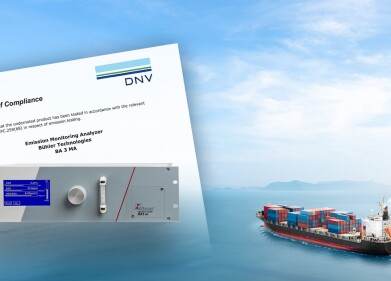Measurement and testing
pH Control of Boiler Feed Water for Oil Refineries and Power Plants
Feb 07 2013
Ultra Pure Water (UPW) dosed with caustic is used to generate steam for oil refineries and power plants. The addition of sodium hydroxide and sodium phosphate raises the pH and creates an oxide layer on the wetted metal surfaces that protects against corrosion. The control of chemical addition relies upon accurate pH measurement. There are usually 2 pH measurements – the first for the feed UPW and the second to control dosing of NaOH/ NaH2PO4 in order to raise the pH to the required level.
pH measurement and control of UPW has proven to be very unreliable using conventional porous reference electrodes. Solutions that have been suggested and tried include flowing junction electrodes (with large reservoirs that constantly replenish reference electrolyte), multiple junction electrodes, micro-junction electrodes and gel type electrodes. All of these solutions suffer from the same problem – they have a reference electrode that is in intimate contact with the process and therefore exhibit both diffusion potential errors as KCl migrates from the electrode (osmosis effect) and continuous mV drifting Eo zero point change caused by electrolyte dilution in the reference half-cell. Conventional probe life is typically short (compared to when used in more “standard” applications) requiring costly frequent probe replacement and flowing junction electrodes represent a large maintenance overhead making cost of ownership prohibitive.
The patented REFEX (Europe) reference system is NON-POROUS – made using an ionically conductive polymeric material that acts as an immobilised electrolyte and forms a separating interface barrier preventing all liquid exchange/contact between the reference electrolyte and the UPW water in the process stream. The REFEX polymeric interface has removed the need for special ‘Porous-Junction’ designs and has made accurate and reliable pH measurement and correction of hot UPW truly possible for the first time. The REFEX interface/barrier cannot be poisoned or fouled so the mV integrity of the REFEX reference is guaranteed over long periods of continuous use.
Conventional reference electrodes are slow to respond to pH change because of limited electrical pathway through the porous junction. This delay can create serious ‘chemical over-dosing’ an expensive waste of chemicals – but more importantly can affect the consistency of the corrosion protecting oxide layer on wetted metal surfaces.
With no porous junction, a REFEX reference system reacts immediately to pH change and this rapid response to pH change allows precise control of the addition/dosing of NaOH and NaH2PO4. Using the REFEX electrodes guarantees exact chemical dosing, ensuring the consistency of the corrosion preventing oxide layer while providing considerable savings in chemical costs too. Refex's online analysers will also be releyable meaning less lab samples will be needed. Lab samples from boiler feed water is always a risk because of temperature and pressure.
The use of REFEX electrodes for pH measurement in boiler feed water and chemical correction applications provides a transforming improvement that greatly increases efficiency in accuracy – immediate response to pH change, consistent corrosion protection and significant chemical savings.
Digital Edition
PIN 26.1 Feb/Mar 2025
March 2025
Analytical Instrumentation - Elemental Analysis for Quality and Process Control at Refineries, for Lubricants and Wear Metals in Engine Oils - Synthetic Lubricants: New Developments - Scaling...
View all digital editions
Events
Apr 08 2025 Birmingham, UK
Apr 08 2025 Kielce, Poland
Apr 08 2025 Ravenna, Italy
Apr 08 2025 Southampton, UK
Apr 08 2025 London, UK
























